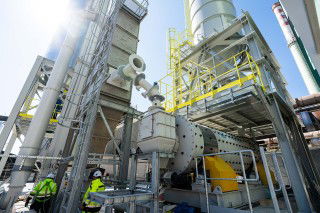Cemex CEO, Fernando Gonzalez, opened the Cemex Day 2018 on 15 March, claiming that over the last four years they had built a stronger company, including achieving a US$6bn debt reduction and the highest net income in a decade at US$800m. Troubling countries for Cemex were Colombia and Egypt, but the multinational still delivered EBITDA of US$2.6bn in 2017.
The company also announced US$250m strategic capex spending for 2018, targetting assets in the emerging cement markets of Brazil and India. However, the company's subsequent decision this week to shelve its proposed capital increase, following consultation with its shareholders, would suggest that any immediate plans for expansion have been put on hold.
Nevertheless, the finances of the company have seen significant improvement and CFO, Jose Antonio Gonzalez, reported that cash interest payments had fallen from US$1423m in 2013 to US$821m in 2017, down by 42 per cent or US$600m.
Three pillars for Cemex strategy
The forward strategy for Cemex was provided at Cemex Day 2018 by Juan Pablo San Agustín, EVP strategic Planning and New Business Development at Cemex. The three main pillars for the growth strategy are: leverage of the existing core network of cement aggregates and ready-mix, enabling of new digital technologies and entry into new markets. Cemex sees Brazil, India, eastern Europe, central and southeast Asia as main areas for future investment.
Domestic expansion
In the domestic cement market of Mexico, Cemex saw improved EBITDA, which increased 10 per cent YoY to US$1145m from US$1041m. In addition, the company noted a rise in cement prices per tonne by 16 per cent in 2017, exceeding the 15 per cent CAGR from 2014 to 2017. In terms of production, alternative fuel substitution has risen to 21 per cent in 2017 and kiln stoppages have fallen from 199 to 127 in the same period, while the clinker factor is now at 74 per cent.
Juan Romero, Cemex Mexico President, pointed out that the main drivers for cement demand were the rise of the middle class, growing housing and industrial needs, structural reforms and strong US growth. While GDP in Mexico is forecast by Banxico to expand by 2.3 per cent in 2018, construction should also pick up by two per cent this year.
Cemex Mexico is currently responding to these market growth expectations by expanding its Tepeaca cement plant by 1.5Mta in a first upgrade phase, which should be completed in 2019. The Huichapan cement works will also have its cement capacity raised by 0.4Mta in 2018.
USA
The United States remains a core market for Cemex. EBITDA increased by nine per cent in 2017 to US$602m from US$555m the previous year and the company enjoyed improved price realisation (+5 per cent YoY) while it was able to limit cost rises to one per cent.
Looking ahead, the company is well-positioned to take advantage of the strong residential outlook in Florida where YoY single-family starts are up by 12 per cent. California and Arizona offer opportunities in highway development, which is up six per cent YoY, while house reconstruction projects are expected to push the Texan residential new commercial builds up by four per cent in 2018. The forward trend for housing starts in Florida from 2017-22 is a CAGR of 10 per cent and highways and street cement demand in California for the same period is expected to expand by 11 per cent CAGR. Florida is forecast to lead US cement demand growth between 2017-22 with a CAGR of 7.9 per cent.
Central America and the Caribbean
The 22 per cent YoY fall in EBITDA to US$477m in the company's Central America and Caribbean division was mainly accounted for by the decline in EBITDA in Colombia, where demand remained flat. However, the Caribbean delivered good returns as cement demand was robust in Guyana, Barbados, Haiti, Dominican Republic, Jamaica and Puerto Rico. In addition, Guatemala, Costa Rica, Panama and Peru also delivered growth in demand.
On the production side, alternative fuels use is relatively low at 10 per cent, while clinker factor has reached 73 per cent in 2017.
Europe
Cemex derives 48 per cent of its European revenues from the cement sector with a regional portfolio that supplied 11.1Mt of cement in 2017 up from 10.3Mta in 2016. Jaime Elizondo, President of Cemex Europe, pointed towards Spain as the significant growth market for the company as demand in the country is forecast to rise by more than five per cent between 2017-22. Housing is pushing cement demand up across all of Europe, buoyed by refugee flows. Cement prices have remained steady at US$73.60/t.
In terms of costs, some US$70m of savings were made through the use of alternative fuels. Poland leads thermal substitution rankings in the region with 77 per cent, followed by Latvia (73 per cent) and Germany (71 per cent), while Spain is still down at 33 per cent.
Asia, Middle East and Africa
Joaquín Estrada, President of Cemex Asia, Middle East and Africa, highlighted that 40 per cent of the divisions EBITDA came from its Philippines operations and 37 per cent from its Assiut Cement subsidiary in Egypt. The division supplied 10Mta of cement and although cement prices are stabilising in terms of local currency, Egypt's revenue has been hit by the devaluation. Pressure on prices in the Philippines continued. Average regional cement prices have fallen from US$84/t in 2016 to US$63/t in 2017. The Philippines has the highest kiln efficiency in Cemex at 94 per cent and further debottlenecking will improve efficiency. Around US$225m is being invested in the Solid Cement plant expansion, which is scheduled for completion in 1Q20.
